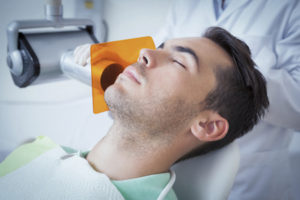Nothing to Fear
In spite of the dental technology that has made dentistry virtually pain-free, dental fear and anxiety still keeps millions of patients away from the dental office every year. For these patients, local anesthesia is not enough to treat the psychological factors of their condition. A sedative is often needed to put them at ease during dental treatment. Conscious sedation is an excellent alternative to treat dental anxiety so your dentist can get to work on your teeth! Conscious sedation dentistry allows you to enter a state of relaxation while staying awake during the procedure. Although you won’t feel any pain, you will be able to respond to your dentist’s questions and commands. As communication is key with any dentist-patient relationship, conscious sedation is an excellent option for fearful dental patients.
Dental Sedation in a Nutshell
There are several types of sedation dentistry used to treat different levels of dental anxiety, each putting you in varied states of relaxation:
Light Sedation—with minimal sedation, you are relaxed while remaining awake and alert.
Moderate Sedation—you will remain conscious during a procedure, but you probably won’t remember much about it. While you’re able to communicate, you may feel groggy and slur your words. Some patients do fall asleep with moderate sedation but can be easily woken back up.
Deep Sedation—this renders you either semi- or totally unconscious during your dental procedure, and does not usually fall under the category of conscious sedation. You will not regain consciousness until the drug wears off or is reversed, and recovery time takes longer. Most forms of conscious sedation is also referred to as sleep dentistry even though you remain awake during the procedure!
Choose your Administration
There are several ways conscious sedation can be administered:
Inhalation Sedation—Nitrous oxide, or laughing gas, is considered a light form of dental sedation. Your sedation dentist will administer the nitrous oxide though a mask that’s placed over your nose. The gas is inhaled through the nose and expelled through the mouth. When the procedure is over, the nitrous oxide wears off almost immediately with minimal to no side effects or recovery time.
Oral sedation—oral medication used for sedation purposes produces a light to moderate effect depending on the strength of the prescription. Oral sedation usually comes in the form of a pill taken an hour before the procedure. Although you’ll be able to respond to your dentist’s commands, you may feel sleepy. Recovery time will take longer, and you’ll need an escort to drive you home. Although rare, side effects may include nausea and vomiting.
IV Sedation—like oral sedation, IV sedation is considered moderate. The difference is the drugs are delivered intravenously, producing an effect much sooner. IV sedation also allows your dentist to adjust the level of sedation needed during the procedure.
General Anesthesia
Note that general anesthesia is not included on the above list. General anesthesia is a form of deep sedation, and it is the only dental sedation that puts you to sleep. But before you jump at the chance of using general anesthesia to treat your dental fear, you should understand all that is involved.
General anesthesia can only be administered by and anesthesiologist, dental anesthesiologist or oral and maxillofacial surgeon. If your general or cosmetic dentist doesn’t have the facilities or certifications needed for general anesthesia—and most don’t—you may need to have your work done in a hospital, which includes separate fees. There are also certain risks involved with general anesthesia that are not present with conscious sedation dentistry; one example is the need for assisted breathing. Regardless, general anesthesia may be an option for those who don’t respond to conscious sedation, need extensive dental work or are too mentally or emotionally disabled to understand the nature of their dental visits.
Going Local
Conscious sedation is not a painkiller, and in most cases you’ll still need a local anesthetic during your dental procedure. If you strictly suffer from a fear of needles, conscious sedation can help. With conscious sedation, your dentist will easily be able to administer shots of anesthesia while your mind wanders elsewhere.
 Not to be Taken Lightly
Not to be Taken Lightly
Conscious sedation is considered relatively safe—but as with any medicine, there are risk factors. To ensure your safety, dental sedatives should only be administered by those with appropriate training. Your dentist will consider your health background when choosing a form of dental sedation for you. We’re the first step in helping you get back on the road to excellent dental health!! Call Us Today!!
